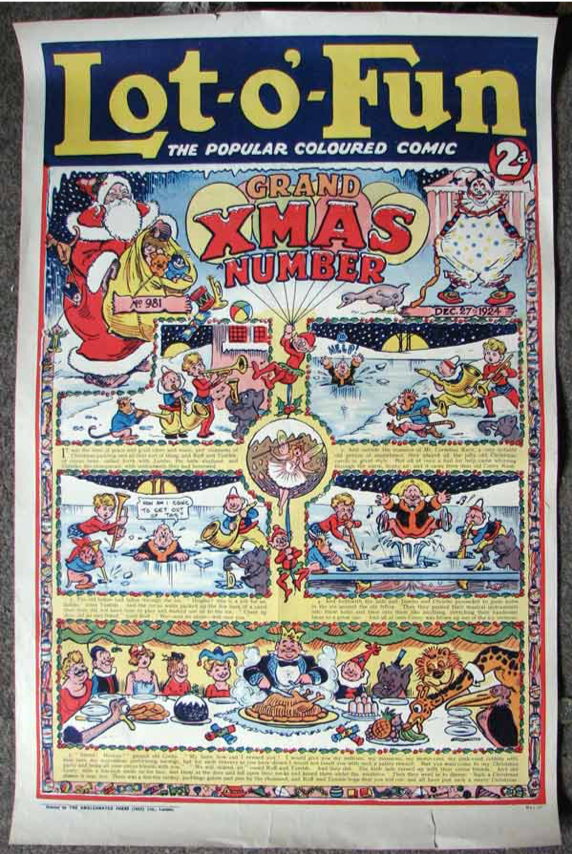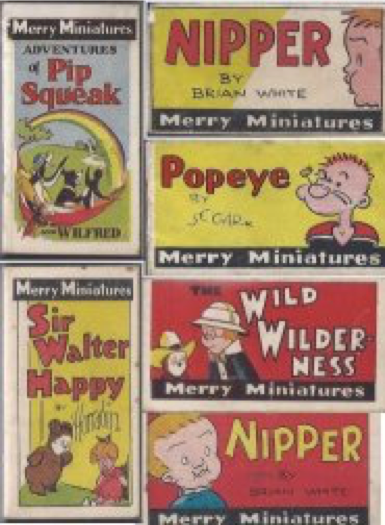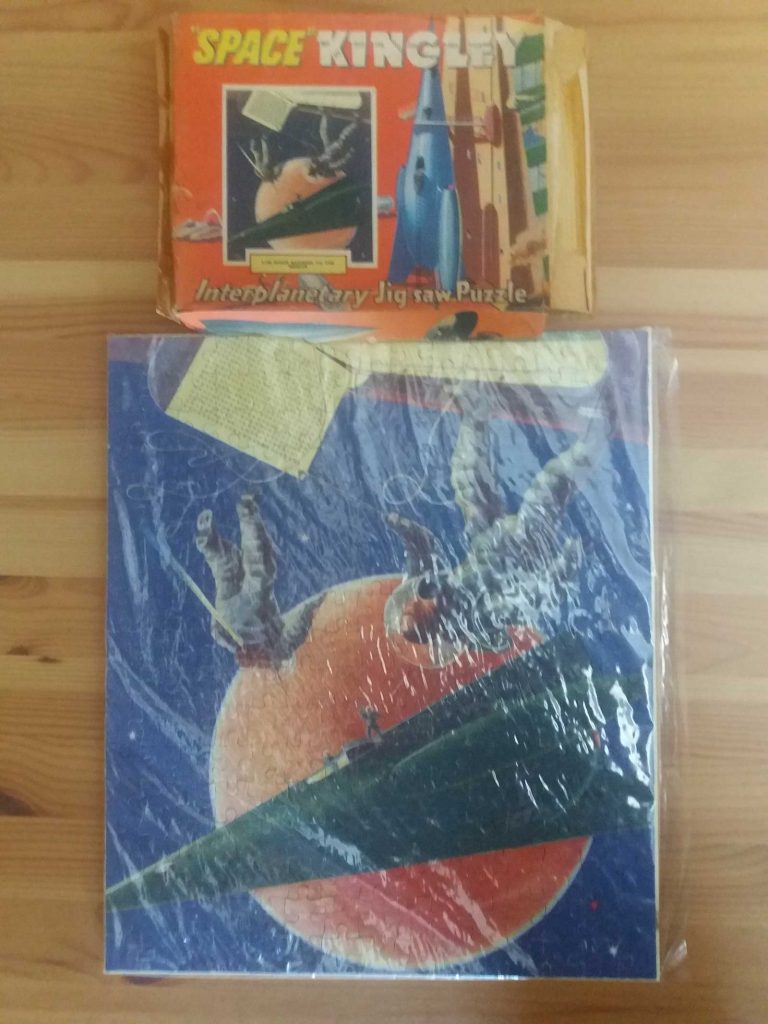There are times in a comic artist’s life when work temporarily dries up, or they are offered a more financially rewarding project. Despite the theory that artists are doomed to starve in garrets for their art, the reality is “if the money is offered, take it”. More often than not the project offered is in the merchandising or commercial market. This post takes a short look at some well-known names by way of explanation…
In pre-war Britain the comic market was booming, and there were many comics vying for your pocket money. Amalgamated Press had long practised enticing their readership with grand non-comic free gifts, such as Herbert Foxwell’s beautiful posters presented free with The Rainbow comic in the early 1920s.
Later, they periodically issued newspaper hoardings to advertise their wares, and who better to do that than the artists that they already used in the comics. Bertie Brown drew this one in December 1924 for Lot-O-Fun.
Designed to be used only for a week, these pieces of comic ephemera give a marvellous insight into “extra-curricular’ comic artistry.

In 1934, a marketing company called Home Publicity was working on behalf of a national brand of confectioners. They offered many well-known artists the opportunity to supplement their wages by creating small folded or booklet style comics that were to be given away free at sweetshops round the country.
 A.B. Payne contributed adventures of his popular Pip, Squeak and Wilfred; the great Herbert Foxwell told some tales of the Bruin Boys; whilst Nipper artist Brian White also contributed. Unlike the British strips, the Popeye stories by Segar were US reprints. These were tiny comics measuring a mere 1.5 x 2.5 inches.
A.B. Payne contributed adventures of his popular Pip, Squeak and Wilfred; the great Herbert Foxwell told some tales of the Bruin Boys; whilst Nipper artist Brian White also contributed. Unlike the British strips, the Popeye stories by Segar were US reprints. These were tiny comics measuring a mere 1.5 x 2.5 inches.
Although there were at least 30 different titles issued, collecting them today is challenging to say the least.
Artist D.C. (Derek Charles) Eyles will forever be associated with the Wild West Weekly of the 1930s and the Knockout and Kit Carson annuals of the late 50s.
In fact, there was hardly a Boys Adventure Book or Popular Girls Book of the 1920s and 1930s (of which genre there were plenty) that failed to have at least one full colour plate by Eyles. His book illustrations turn up in such titles as Captain Mayne Reid’s The Scalp Hunters and Knights of the Round Table. But when offered the opportunity to create the images for jigsaw puzzle manufacturer, he took it.

Eyles was a dab hand at drawing horses and it was natural that the choice of the jigsaw puzzles were excellent renditions of Cowboys, Indians chasing stagecoaches, dust and blazing six-guns.
During the 1940s, the world had other concerns, so we move into the 1950s. Although jigsaw puzzles have been around since the mid-eighteenth century, it can be said that the 1930s and 1950s were the Golden Age. Jigsaws puzzles, card and board games were what a family would do after the tea things were cleared away. For jigsaws every conceivable subject was created, and someone was needed to create the images from which the wood (later card) could be cut.
Many anonymous hands created puzzles depicting ships, trains, village greens, far flung Empirical outposts and more. But popular culture, especially radio and comics were already envisaging the future. The Eagle burst onto the scene in April 1950 with its front page hero Dan Dare and one of the most popular radio series’ of 1953 was Journey into Space, broadcast on the BBC Light Service and featuring such names as Andrew Faulds, Alfie Bass and a pre-Juke Box Jury, David Jacobs.
Obviously a jigsaw was required, and actually four Journey into Space puzzles were commissioned by Tower Press, one of the biggest manufacturers of puzzles at this time. The artist chosen for the work was Ron Jobson.
Jobson was always a commercial artist rather than a comic artist, but in the wake of the interest in space themes he went on to produce three “Space Kingley” books that were very popular. As a result of that, Samson Low, his publisher, requested him to create four “Space” Kingley jigsaws.

Space Kingley jigsaw by Ron Jobson, the jigsaw carefully protected from damage in this photograph
By this time the spaceways were getting a bit crowded, what with Dan, Kingley, Captain Condor (Dan’s competitor from Lion), Rick Random, not to mention Mick Anglo’s ISS and a myriad of other space heroes it was getting difficult to find a parking space for your shuttle. Marketing for Dan Dare started virtually from the first issue of Eagle, some of these were produced by the UK company J. & L. Randall trading under the name Merit, who also marketed their products in Italy where Dan was also popular.
I suspect that Messrs. Hampson and Harley (even if they were asked, and there is no proof that they ever were) would have been too busy to answer Merit’s call for recognisable Dan Dare box art. So they contracted WDL artist Walt Howarth to design their Dan Dare related boxes, including the quite scarce Dan Dare Walkie-Talkie box.

A Dan Dare 2 Way Walkie-Talkie Set (1953) produced by J & L Randall Ltd. This collectible, sold by ComPal in 2012, was complete with two handsets secret decoder and two-colour wire connection ‘It really works’.
Howarth had an uncanny ability to capture a person’s likeness, a gift that would stand him in good stead throughout his career. While this was going on, the creator of the Lion’s Captain Condor, Frank S. Pepper, was ensuring that he retained merchandising rights on his creation, and some revenue on all Captain Condor watch sales.

1950s Captain Condor Watch
During the mid- to late-1950s, TV was starting to become a phenomenon, even if you only had one channel you already had your favourite programmes. TV Fun had started in September 1953, and that old veteran Film Fun had started publishing TV related strips; World Distributors Limited had been publishing TV-related comics and annuals (mostly westerns) since 1954; Pearson started TV Picture Stories in 1959. So what about some TV themed jigsaws?
For approximately a decade (mid-1950s to mid-1960s) Tower Press released dozens of jigsaw puzzles based on popular British and American television series’. Appropriately enough they seem to have started with early British Watch with Mother subjects such as The Flowerpot Men and Sooty, and gradually expanded into more popular children’s TV shows. There were six Robin Hood puzzles released in 1957, ATV’s The Buccaneers puzzle appeared in 1958, and the Buckskin Buccaneer himself, Davy Crockett, also got two puzzles in 1958.
Wagon Train and Tales of Wells Fargo all got puzzles during the next six months – there was just one problem, none of this artwork looked like the actors that played the characters! The Cheyenne puzzles – all six of them – were particularly appalling.
Then something wonderful happened. In 1959, Tower Press contracted Walt Howarth to draw the images for The Deputy, Laramie, Tenderfoot (aka Sugarfoot in US), Klondike, Union Pacific, Ty Hardin, and Hawaiian Eye. As the popularity for westerns declined, he created puzzles for The Beverley Hillbillies, Danger Man, The Man from U.N.C.L.E. and Daktari, as well as the pop jigsaws, Rolling Stones, The Beatles, and The Dave Clark Five and finally finishing with Steptoe and Son.

A Dave Clark Five jigsaw illusyrated by Walt Howarth. Instead of the more normal “340 Pieces” the box lid states the jigsaw features “340 Bits and Pieces”, the name of a big hit for Dave Clark in 1964.
The characters were instantly recognisable, and you could sent a large stamped addressed envelope to Tower Press for a real print of the image – fantastic. Most of these puzzles are under 400 pieces and are generally overlooked by enthusiasts for that reason – they lack the challenge that puzzlers crave.
“Space Commander Kerry”
• This article is only an initial look at the work done by comic artists in the commercial world. If you know of other examples we would love to hear from you
• The Dan Dare Info Site has images of the various Dan Dare and Journey into Space puzzles here
One of many guest posts for downthetubes.
Categories: downthetubes Comics News, downthetubes News
 FML, new creator-owned series from Kelly Sue DeConnick and David López, promoted with ingenious guerrilla marketing
FML, new creator-owned series from Kelly Sue DeConnick and David López, promoted with ingenious guerrilla marketing  Dark Horse, Hasbro, tease new Dungeons & Dragons, Magic: The Gathering projects
Dark Horse, Hasbro, tease new Dungeons & Dragons, Magic: The Gathering projects  The SEQUENT’ULL Interviews: Dan White
The SEQUENT’ULL Interviews: Dan White  Sports comic highlights an immortal rugby match
Sports comic highlights an immortal rugby match
I am a bit concerned about a Dan Dare Walkie Talkie that came “complete with two handsets, secret decoder and two-colour wire connection”! The wire must have restricted the amount of walking the users could do. I imagine the only ‘string theory’ around then was how to keep the cord tight between two empty soup cans, so that the vibrations created by talking into one were heard as sounds at the other. Happy days.